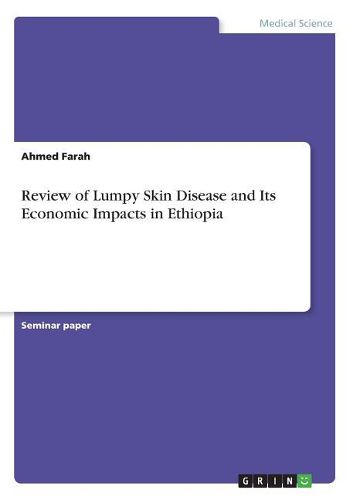Readings Newsletter
Become a Readings Member to make your shopping experience even easier.
Sign in or sign up for free!
You’re not far away from qualifying for FREE standard shipping within Australia
You’ve qualified for FREE standard shipping within Australia
The cart is loading…






Seminar paper from the year 2017 in the subject Health Science, grade: A, Mekelle University (College of veterinary medicine), course: Seminar Paper, language: English, abstract: Lumpy skin disease (LSD) is among the most economically significant viral diseases of cattle caused by Neethling virus prototype strain classified in the genus Capripoxvirus of family Poxviridae. The disease is characterized by fever, enlarged lymph nodes, firm and circumscribed nodules in the skin. Lumpy skin disease is currently endemic in most Sub-Saharan African countries and subsequently spread to the Middle East, Asia and to European countries. It is an economically devastating viral diseases which causes several financial problems in livestock industries as a result of significant milk yield loss, infertility, abortion, trade limitation and sometimes death in most African countries including Ethiopia. In Ethiopia lumpy skin disease was first observed in the northwestern part of the country (southwest of Lake Tana) in 1983. It is now spread to almost all regions and agro-ecological zones of the country. Major epidemic outbreak of LSD has been documented in different regions of Ethiopia at different time period. From 2007 to 2011 a total of 1352 disease outbreaks of LSD have been documented. The highest outbreak was registered in Oromiya region and the lowest in Afar region. All breeds and age group, both sex are susceptible however, Bos Taurus are particularly more susceptible to the clinical disease than Bos indicus. The various agro climatic conditions, introduction of new animals to the herd and the presence communal watering bodies are regarded as major risk factors that would facilitate the spread of outbreaks in diverse localities. LSD is transmitted by mechanical vector insects and also wildlife plays a potential role in its maintenance and could be diagnosed using appropriate serological and molecular techniques. The herd-level LSD prevalence is significantly higher in the
$9.00 standard shipping within Australia
FREE standard shipping within Australia for orders over $100.00
Express & International shipping calculated at checkout
Seminar paper from the year 2017 in the subject Health Science, grade: A, Mekelle University (College of veterinary medicine), course: Seminar Paper, language: English, abstract: Lumpy skin disease (LSD) is among the most economically significant viral diseases of cattle caused by Neethling virus prototype strain classified in the genus Capripoxvirus of family Poxviridae. The disease is characterized by fever, enlarged lymph nodes, firm and circumscribed nodules in the skin. Lumpy skin disease is currently endemic in most Sub-Saharan African countries and subsequently spread to the Middle East, Asia and to European countries. It is an economically devastating viral diseases which causes several financial problems in livestock industries as a result of significant milk yield loss, infertility, abortion, trade limitation and sometimes death in most African countries including Ethiopia. In Ethiopia lumpy skin disease was first observed in the northwestern part of the country (southwest of Lake Tana) in 1983. It is now spread to almost all regions and agro-ecological zones of the country. Major epidemic outbreak of LSD has been documented in different regions of Ethiopia at different time period. From 2007 to 2011 a total of 1352 disease outbreaks of LSD have been documented. The highest outbreak was registered in Oromiya region and the lowest in Afar region. All breeds and age group, both sex are susceptible however, Bos Taurus are particularly more susceptible to the clinical disease than Bos indicus. The various agro climatic conditions, introduction of new animals to the herd and the presence communal watering bodies are regarded as major risk factors that would facilitate the spread of outbreaks in diverse localities. LSD is transmitted by mechanical vector insects and also wildlife plays a potential role in its maintenance and could be diagnosed using appropriate serological and molecular techniques. The herd-level LSD prevalence is significantly higher in the